How to cook the perfect goulash
The Hungarian original may properly be a soup, but the rich meaty flavours and distinctive spice of sweet paprika work brilliantly in this thicker stew version
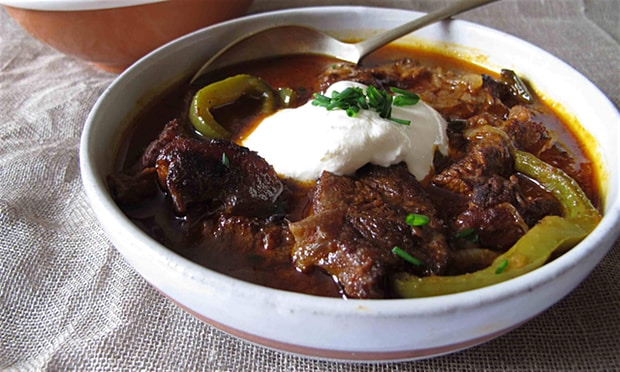
Felicity Cloake's perfect goulash: sour cream and chives optional. Photograph: Felicity Cloake
Goulash is a dish with dual nationality. In its traditional Hungarian form, it's a soup, a thin broth studded with meat apparently favoured by cowboys (gulyás) – a kind of central European chilli con carne, if you like. Almost everywhere else, however, it refers to the spicy meat stew known in its homeland as pörkölt (or paprikás, depending on the addition, or not, of sour cream). As we are not in Hungary, this article is concerned with the second variety – a rich stew rather than a soup. Those familiar with the first sort should thus read pörkölt for goulash thoughout.
To be honest, the two dishes are not dissimilar, both characterised by a generous amount of brick-red paprika, a spice that only became popular in Hungary in the early 19th century, and which sets them quite apart from all the other beef stews you could choose to warm up a chilly spring evening. Indeed, Hungarian restaurateur George Lang writes in his book of traditional recipes that if you cook off most of the liquid in a goulash, and "cook the meat down to its fat you get pörkölt", allowing me to try both in pursuit of perfection.
The meat
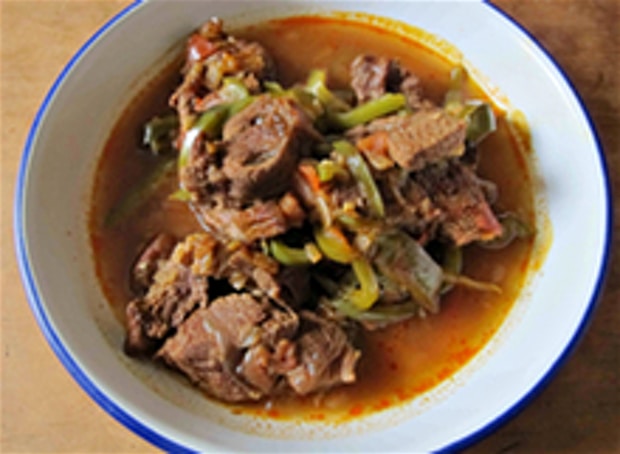
George Lang's goulash: suggests using chuck steak Felicity Cloake
Although almost any meat can be given the goulash treatment, including pork, poultry and game such as rabbit, beef is perhaps the original, if you believe the cowboy story, and certainly the most popular candidate. Simon Hopkinson and Lindsey Bareham observe in The Prawn Cocktail Years that it's how you treat it that matters – "whichever meat you decide on, long, slow cooking is the key". And, as we all know, long, slow cooking demands meat with a proper lubrication of nasty sounding stuff such as "fat and sinew" which will obligingly melt into delicious richness in the fullness of time.
The chuck steak that most recipes – including those from Lang and chef Louis Szathmáry, Hungarian food blogger June Meyer and our very own Delia Smith – suggest falls down in this respect. Although it's tender, it's disappointingly dry, leading me to suspect that modern chuck is leaner than would be traditional. Hopkinson and Bareham use top rump, which is better but still not ideal, and Patience Gray and Primrose Boyd, authors of the wonderful 1957 collection of one-pot meals, Plat du Jour, rump steak, which is certainly wasted here. Thankfully, Hugh Fearnley-Whittingstall recommends my old favourite, shin, which, to no one's surprise, delivers perfectly, falling apart in gelatinous strands under our forks. Try and get it if you can.
The paprika
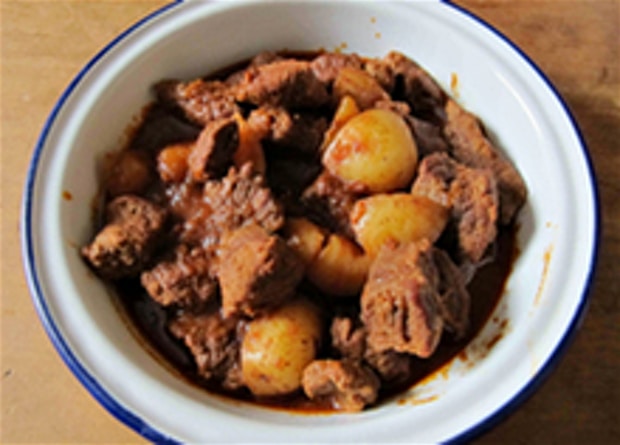
June Meyer's goulash: 'You can never use too much paprika' Felicity Cloake
Although the pimento pepper is a native of the new world, Hungary can fairly claim credit for its dried form, paprika. The very best is still said to come from the south of the country, and, having done a comparative tasting, I recommend investing in some decent Hungarian sweet stuff if you can – it's far fruitier and noticeably less bitter than the jars marked "paprika" in the supermarkets. (I also try Hungarian hot paprika, as Szathmáry and Gray and Boyd's recipes don't specify what sort to use, but I think this is more commonly deployed as a table condiment in this context.)
According to Szathmáry, writing in The Oxford Companion to Food, paprika would originally have been rubbed into meat as a preservative – when cooked, this meat "formed a brown crusty surface with a pleasantly different taste resembling that of meat roasted over an open fire to the point of almost burning". (In fact, this is how the dish got its name, pörkölt being the Hungarian name for this browning process.) Despite their vagueness about the variety of paprika, only Szathmáry and Gray and Boyd go on to coat the meat with it before browning it, a step which seems pretty important to me.
Hopkinson and Bareham cleverly use pepperoni sausage (I manage to find a Hungarian paprika-spiked mangalitza version) a "controversial" addition which works brilliantly at adding extra spice and richness. Inspired though it is, however, I don't think it's necessary if you use enough paprika and traditional pork fat, rather than their olive oil and butter. Meyer has the right idea when she says: "You can never use too much paprika. I like to use three tablespoons." And hurrah for that.
You say tomato …
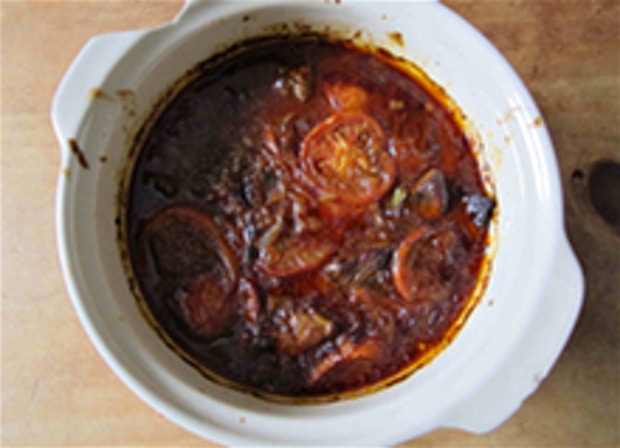
Plat du Jour's goulash uses rump steak Felicity Cloake
Meyer can afford to be heavy handed with the paprika, because her recipe contains very little else: "My family would never consider tomatoes or green peppers or other spices in goulash. Some other dishes would have tomato or green pepper, but not goulash." Both these additions are indeed popular in the recipes I try. Lang and Gray and Boyd use fresh tomatoes, and Szathmáry tomato puree, while Lang also sticks in green peppers, Szathmáry red or green, and Hopkinson and Bareham the roasted and jarred variety.
Though tomato might seem a natural addition to a bright red stew, I love the rich flavour of the paprika in Meyer's and Bareham and Hopkinson's versions, and I think it should be allowed to speak for itself.
Peppers, however, are a different matter; this is one of the few dishes where the distinctive herbaceous bitterness of the green variety is a boon – they just taste right here, somehow. If you're not a fan, however, feel free to use the red sort, or leave them out altogether with Meyer's blessing.
Gravy
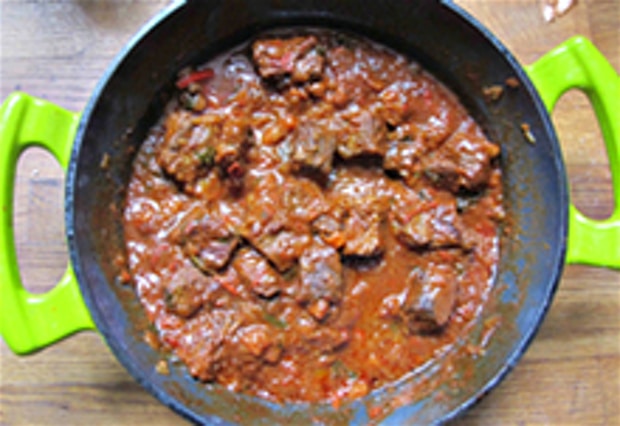
Louis Szathmáry's goulash: uses flour to thicken. Felicity Cloake
Lang is reported to have had "very strong opinions" on goulash: "Never use any other spice besides caraway. Never Frenchify it with wine. Never Germanise it with brown sauce." I'm with him on the caraway, another distinctively central European flavour, and after trying a recipe using red wine and beef stock from Gray and Boyd, and one using white wine from Hopkinson and Bareham, I'm inclined to think he's right about using water as the base of the gravy too. While wine and stock are, of course, excellent things to put into a beef stew, they make this particular one taste like any number of others – again, I want paprika to be the dominant flavour here, which is also why I'm leaving out Lang's garlic and Szathmáry's garlic salt. Simple is the order of the day for this cowboy classic.
<>p>I will be taking a leaf out of Hopkinson and Bareham's book and adding some lemon juice, however; though you can garnish the finished dish with sour cream if you like, the gravy itself benefits from a little acidity to balance all that sweet spice. Thickeners may not be entirely necessary in a soup, but flour is a common addition, and a useful one in creating a really thick, rich gravy for my stew, so, though purists may sneer, if it's good enough for Szathmáry, it's good enough for me.Sour cream
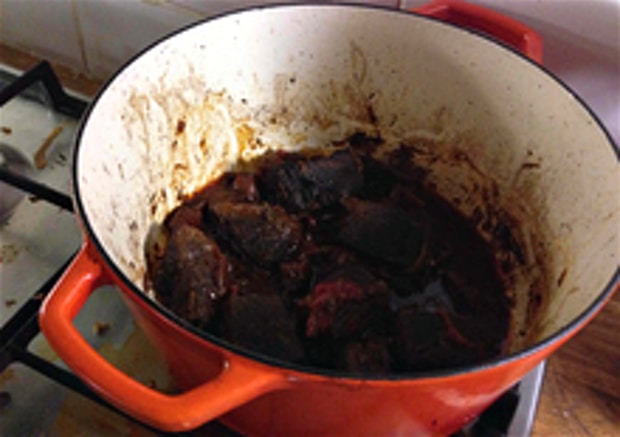
Hopkinson and Bareham's goulash: adds cubed salami for extra spice. Felicity Cloake
Only Hopkinson and Bareham include a sour cream garnish in their recipe, but then most of the others are intended to be thinner, soupier affairs, topped with dumplings and potatoes instead. Personally I think the contrast between the cool, tangy cream and the rich, spicy sauce elevates what is essentially a very satisfying stew to real greatness. It also turns what is, strictly speaking, a pörkölt into a paprikás, but I won't tell if you don't.
- 600g shin of beef (or chuck steak if unavailable)
- 3 tbsp sweet Hungarian paprika
- 1 tbsp flour
- 1 tsp salt
- 1 tsp caraway seeds
- 2 tbsp lard
- 2 onions, thinly sliced
- 1 green pepper, cut into rounds
- Juice of 1 lemon
- 150ml sour cream (optional)
- Chives (optional)
Felicity Cloake's perfect goulash
(serves 4)Cut the beef into large chunks. Mix the paprika, flour, salt and caraway seeds together in a bowl then add the beef and toss to coat. Heat the oven to 140C/gas mark 1.
Melt the lard in a heavy-based casserole dish over a medium-high heat, and then brown the meat in batches, being very careful not to crowd the pan. Remove when golden and crusted, and set aside.
Scrape the bottom of the pan and add the onions and pepper, adding a little more fat if necessary. Cook until soft and starting to brown, then pick out the peppers and set aside. Stir the remaining flour and spice mixture into the onions and cook for a couple of minutes, stirring. Return the beef to the pan and add water just to cover. Scrape the bottom of the pan again, then put in the oven for 2.5 hours.
Stir the peppers and lemon juice into the goulash and cook for another half hour, or until the meat is very tender - you can remove the lid to let the sauce reduce if you like. Check the seasoning, then dollop the sour cream, if using, on top of the goulash and snip the chives over it all before serving with crushed boiled potatoes or egg noodles.
Goulash: would you have preferred a traditional soup, or a defiantly nontraditional take on the classic, like Delia's tomatoey, smoky Spanish version? And does anyone have a good vegetarian goulash recipe they would like to share?